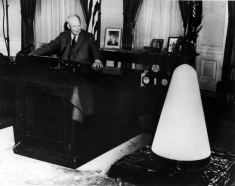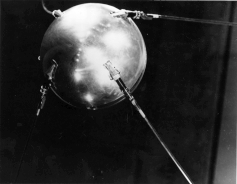
Before a national television audience, President Dwight D. Eisenhower displays a nose cone from a Jupiter-C missile on August 7, 1957.

The Sputnik I spacecraft.
![]()
![]()
One Small Ball in the Air: October 4, 1957November 3, 1957
On Friday, October 4, 1957, U.S. domestic news was dominated by Eisenhower's decision to send troops to Little Rock, Arkansas, to enforce civil rights legislation integrating the schools. When Americans heard about Sputnik, some stepped outside to look for the racing spot of light moving across the crisp autumn sky. Others stayed inside to watch the premiere of a comedy television program called Leave it to Beaver.
The Eisenhower administration viewed the Soviet satellite less as a military threat than as a boost to its behind-the-scenes efforts to establish the principle of "freedom of space" ahead of eventual military reconnaissance satellite launches. Sputnik overflew international boundaries, yet it aroused no diplomatic protests. Four days after Sputnik's launch, on October 8, Donald Quarles summed up a discussion he had with Eisenhower: "the Russians have . . . done us a good turn, unintentionally, in establishing the concept of freedom of international space. . . . The President then looked ahead . . . and asked about a reconnaissance [satellite] vehicle."22
That same day, in response to mounting public alarm, U.S. Secretary of State John Foster Dulles sent White House Press Secretary James Hagerty a memorandum on the Soviet satellite. Dulles called the Sputnik launch "an event of considerable technical and scientific importance," but he hastened to add that its "importance should not be exaggerated . . . the value of the satellite to mankind will for a long time be highly problematical." Furthermore, the Dulles asserted, "the United States . . . has not neglected this field. It already has a capability to utilize outer space for missiles and it is expected to launch an earth satellite during the present geophysical year in accordance with a program that has been under orderly development over the past two years."23
The furor over Sputnik's launch took several days to build as opinion-makers struggled to interpret the event in the wider context of U.S. national security. Dulles's comments became the basis for the Eisenhower administration's response to the Soviet satellite. The day after Hagerty received the memorandum, on October 9, 1957, Eisenhower faced the press for the first time since the launch. Seeking to calm Congress and the public, he assured reporters that Sputnik contained "no additional threat to the United States," adding that "from what [the Soviets] say, they have put one small ball in the air." When asked how his administration could have let the Soviets be first in space, Eisenhower said that "no one ever suggested to me . . . a race except, of course, more than once we would say, well, there is going to be a great psychological advantage in world politics to putting the thing up, but . . . in view of the real scientific character of our development, there didn't seem to be a reason for just trying to grow hysterical about it." He added that he had provided the U.S. satellite and missile efforts with funds "to the limit of my ability . . . and that is all I can do."24
Eisenhower's greatest error in the Sputnik "crisis" was his failure to appreciate the psychological dimension of launching the first satellite. Far from being about science solely, Sputnik came to be about the way Americans saw themselves. Many saw Sputnik as confirmation that the Soviets had an operational ICBM, a feat the United States, supposedly the technological leader of the world, could not yet match.25 The administration's efforts to quell fears immediately backfired. Many interpreted Eisenhower's statements as evidence that he was out of touch. NASA Historian Roger Launius has summed up the (unfair) popular appraisal of Eisenhower at the time: "A smiling incompetent . . . a 'do-nothing,' golf-playing president mismanaging events. . . ."26 His comments looked weak placed beside the alarmist statements emanating from Congress. Typical of these were comments by Democratic Senator Richard Russell of Georgia, chair of the Armed Services Committee: "We now know beyond a doubt that the Russians have the ultimate weapona long-range missile capable of delivering atomic and hydrogen explosives across continents and oceans. . . ."27
Many criticized Eisenhower for pinching pennies and making ill-informed decisions without free debate at the expense of national technological leadership and security. As Aviation Week Editor-in-Chief Robert Hotz stated in the first of a series of scathing post-Sputnik editorials:
| We believe that the people of this country have a right to know the facts about the relative positions of the U.S. and the Soviet Union in this technological race which is perhaps the most significant event of our times. They have the right to find out why a nation with our vastly superior scientific, economic, and military potential is being at the very least equaled and perhaps surpassed by a country that less than two decades ago couldn't even play in the same scientific ball park. They also have the right to make decisions as to whether they want their government to maintain our current leadership of the free world regardless of the cost in dollars and sweat. . . . They are not decisions to be made arbitrarily by a clique of leaders in an ivory tower or on a golf course.28 |
On the day Eisenhower faced the media, Senate Majority Leader Lyndon Johnson received his first post-Sputnik briefing from the Pentagon. Johnson was entertaining friends at his ranch near Austin, Texas, when the Sputnik news broke. "In the Open West you learn to live closely with the sky," he wrote later of the night of October 4. "It is part of your life. But now, somehow, in some new way, the sky seemed almost alien."29 In addition to an alien sky over the Texas hill country, Johnson saw in Sputnik an issue important to the nation that could advance his career and party. According to Johnson aide Glen Wilson, Johnson launched plans that very night for a public investigation into the state of U.S. satellite and missile programs in the Senate Preparedness Subcommittee, which he chaired.30
Eisenhower publicly downplayed concerns over Sputnik, but behind the scenes, he took modest steps to counter the Soviet propaganda victory. On October 8, he had asked outgoing Secretary of Defense Charles Wilson to order the Army Ballistic Missile Agency (ABMA) at Redstone Arsenal in Huntsville, Alabama, to ready a Jupiter-C rocket to launch a satellite. Not until November 8, however, did the command reach the Redstone Arsenal and become public.31 The ABMA received authorization from the Army for two launch attempts. Project Vanguard transferred a science instrumentJames Van Allen's radiation detectorfrom one of the later planned Vanguard satellites to the ABMA effort.
By then, the Eisenhower administration had twice as many reasons for launching a U.S. satellite as soon as possible. On November 3, 1957, Korolev's team had launched Sputnik II. The satellite, which included 508 kilograms (1,118 pounds) of payload, was a hastily prepared combination of the PS-2 satellite and a life support capsule for a dog, which was originally designed for brief sounding rocket flights. On board was a canine passenger named Laika.